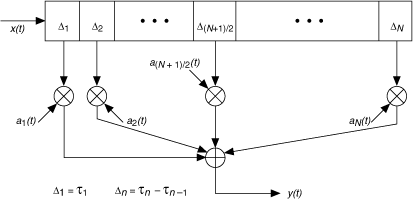Frequency Selective Fading
You can use frequency-selective fading to model discrete multipath wireless channels that are dynamic in both space and time. The input-output relationship for a discrete multipath model is given by the following equation:

where y(t) is the received signal
ak(t) is the complex path attenuation, which is modeled as a random process with a probability distribution that is Rayleigh or Rician for k = 1, , N(t)
N(t) is the number of paths in the multipath channel
 (t) is their corresponding delays
(t) is their corresponding delays
t is time
The Rayleigh fading profile can be implemented using Jakes or Gans models. If the channel model has a line-of-sight path, the envelope of the dominant path (that is, the first path) is Rician distributed. Rician profiles also can be implemented using Jakes or Gans models.
If we assume that the number of multipath components and the delay structure vary slowly compared to the variations in ak (t), the previous relationship can be rewritten as the following equation:

This type of system is a linear time variant (LTV) system and can be implemented using a tapped delay line structure as illustrated in the following figure:

The selective fading profile instances of the MT Generate Fading Profile VI generate Rayleigh or Rician distributed fading profiles for the specified number of paths based on the Jakes or Gans model. The generated fading profile is a two-dimensional array in which the number of rows is equal to the number of paths, and the number of columns is equal to the profile length. The generated profile is passed to the MT Apply Selective Fading Profile VI.